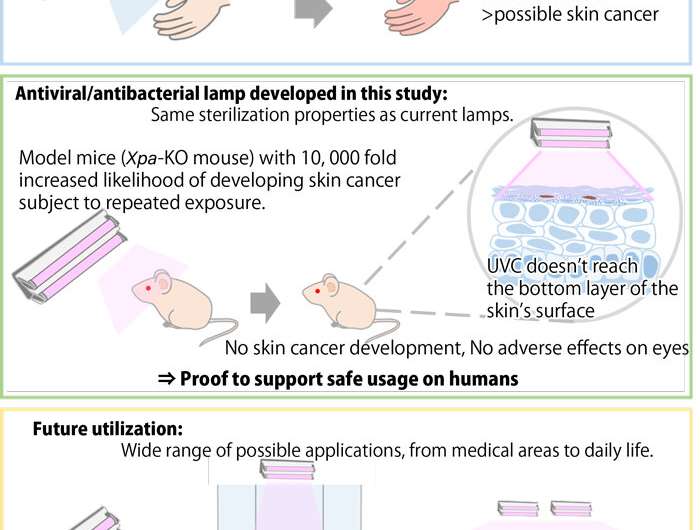Repetitive irradiation with 222nm UVC non-carcinogenic, safe for sterilizing human skin

Joint research between Kobe University and Ushio Inc. has provided proof for the first time in the world that direct and repetitive illumination from 222-nm ultraviolet radiation C (UVC), which is a powerful sterilizer, does not cause skin cancer. This suggests that 222-nm UVC is also safe for human eyes and skin. This technology is expected to have a wide range of antibacterial and antiviral applications in medical facilities and daily life.
The research group consisted of members from the Division of Dermatology in the Department of Internal Related at Kobe University's Graduate School of Medicine (Professor NISHIGORI Chikako, Associate Professor KUNISADA Makoto, graduate student YAMANO Nozomi et al.) and Ushio Inc.
These research results were published online in Photochemistry & Photobiology on March 29 and Professor Nishigori is due to present this research at the American Society of Photobiology 2020 meeting in Chicago on June 28.
Research Background
UVC emitted by the sun (with a wavelength of 280~200 nm) does not reach the Earth's surface because it is absorbed by the Ozone layer. Germicide lamps that emit 254-nm UVC have been developed and are utilized for sterilization because the wavelength can kill bacteria. So far these lamps are only utilized in places when people are not present because they are known to cause harmful side-effects such as skin cancer and cataracts.
The lamp used in this study has a smaller wavelength of 22-2nm. It is being developed in the hope that it can be utilized in the medical field. It has been shown that 222nm is comparable to 254-nm, by the Division of Orthopaedic Surgery at Kobe University (Professor KURODA Ryosuke et.al.), in terms of ability to eradicate bacteria on human skin. However, if this technology is to be directly used on humans in a medical facility, it is necessary to prove that possible repeated exposure to 222-nm UVC is safe and non-carcinogenic.
Research Methodology
To evaluate the safety of repeated eye and skin exposure to a 222-nm germicide lamp, xeroderma pigmentosum group A model mice were used in this study. Compared to wild-type mice, these model mice have an increased sensitivity to ultraviolet radiation and an over 10,000 fold increased risk of developing skin cancer.
In the group that was exposed to UVB (280-315 nm), the wavelength range equivalent to skin cancer caused by sunlight, all mice developed skin cancer and displayed adverse effects such as cataracts and cornea damage.
Conversely, mice in the 222-nm germicide lamp group did not develop skin cancer at all. The effect on their eyes was investigated in cooperation with Shimane University's Department of Ophthalmology (Professor TANITO Masaki et al.). There were no abnormalities visible, even when examined under a microscope (Figure 1).
It was understood that 222-nm produced no adverse effects due to the level of skin penetration. The 254-nm UVC currently used in germicide lamps penetrates down to the basal cell layer, the bottommost layer of the skin, and damages the DNA of cells. On the other hand, it was shown that 222-nm UVC doesn't damage the DNA of skin cells because it only travels as far as the stratum corneum, the outermost layer of the skin.
These research results indicate that even though 222-nm UVC is a powerful sterilizer, it can also be used directly on human skin. Beginning with hand sanitization in medical institutions, it is expected that this technology will have a wide range of antiviral and antibacterial applications in places that people enter, such as schools, welfare facilities, food factories, toilets and kitchens.
More information: Nozomi Yamano et al. Long-term effects of 222 nm ultraviolet radiation C sterilizing lamps on mice susceptible to ultraviolet radiation, Photochemistry and Photobiology (2020). DOI: 10.1111/php.13269
Journal information: Photochemistry and Photobiology
Provided by Kobe University




















